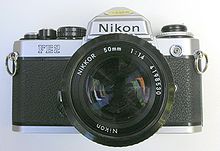Nikon FE
| Nikon FE | |

|
|
| Type: | 35mm - single lens reflex camera |
| Production period: | 1978-1983 |
| Lens connection : | Nikon F bayonet , |
| Film format : | 35 mm (small picture) |
| Recording format : | 24 mm × 36 mm |
| Viewfinder : | SLR |
| Finder Ads: | Aperture, shutter speed |
| Exposure metering : | Center-weighted measurement |
| Measuring range: | EV 1 to EV 18 |
| Correction : | ± 2 EV |
| Closure : | vertical focal plane shutter |
| Shutter speed : | 1/1000 - 8 s, bulb long exposure |
| Synchronization : | 1/125 s |
| Weight: | 590 g (body only) |
The Nikon FE is an analog 35 mm single lens reflex camera from the Japanese manufacturer Nikon with automatic shutter speed and aperture preselection. It came on the market in 1978 and was made entirely of metal. The compact, stable design met with great interest and made the Nikon FE a success. The model designation FE is not visible on the front; it can only be found in small print on the back.
In 1983 the Nikon FE was replaced by the Nikon FE2.
In 1997 Nikon tried again to build on the success of the FE and FE2 with the FE10 model.
Technical characteristics of the Nikon FE
The Nikon FE uses the Nikon proven F bayonet and relies (like the Nikon FM, which was launched in 1977) on the AI coupling introduced in 1977, which significantly simplifies changing lenses.
It has an electronically controlled shutter and therefore, unlike the Nikon FM released a year earlier, requires two button cell batteries. Without a battery, you can take pictures with an exposure time of 1/90 s.
Exposure times between 8 s and 1/1000 s can be set on the setting wheel to the right of the viewfinder. In the Auto position, the camera automatically selects the appropriate exposure time for the set aperture . The current exposure time is continuously displayed in the viewfinder. In the M90 position, you can take pictures mechanically with 1/90 s if there is no battery voltage. If an exposure time is selected manually, the correct exposure can be set using the tracking method. Exposure corrections from −2 to +2 can be made using the adjustment ring to the left of the viewfinder.
With electronic flash units, the Nikon FE synchronizes up to a shutter speed of 1/125 s. The standard ground glass (model K) can be exchanged. The exposure metering works according to the center-weighted aperture metering method. Film speeds (ASA values) from 12 to 3200 can be set using the ASA setting dial.
Successor models
The successor model Nikon FE2
A major improvement over the Nikon FE was the modernized electronics and the fast shutter, which enabled shutter speeds of up to 1/4000 s. Nikon hailed it as the fastest 35mm SLR when it was launched. Other improvements included a. the TTL flash control, a brighter screen.
The successor model Nikon FE10
The Nikon FE10 appeared in 1997 and was completely atypical for that time; z. B. it had no autofocus . The camera was manufactured by the company Cosina for Nikon and should enable beginners to use an inexpensive Nikon camera.
Web links
swell
- ^ A b Winfried Warnke: Nikon: 100 years of photo expertise . Ed .: fotoMAGAZIN 2017-07-25.
- ↑ a b Norbert Michalke: The classic entry: Nikon FE. Retrieved April 23, 2020 .
- ↑ Nippon Kogaku KK (ed.): 3) Nikon FE user manual . 1978.
- ↑ Peter Lausch: Nikon Story: Part 8: Nikon FM, Nikon FE, Nikon FE2 and Nikon EM. Retrieved April 23, 2020 .
- ↑ Peter Lausch: Nikon story: 14th part F5, FM-10, FE-10, Pronea 600i, Pronea S and F60. Retrieved April 23, 2020 .

